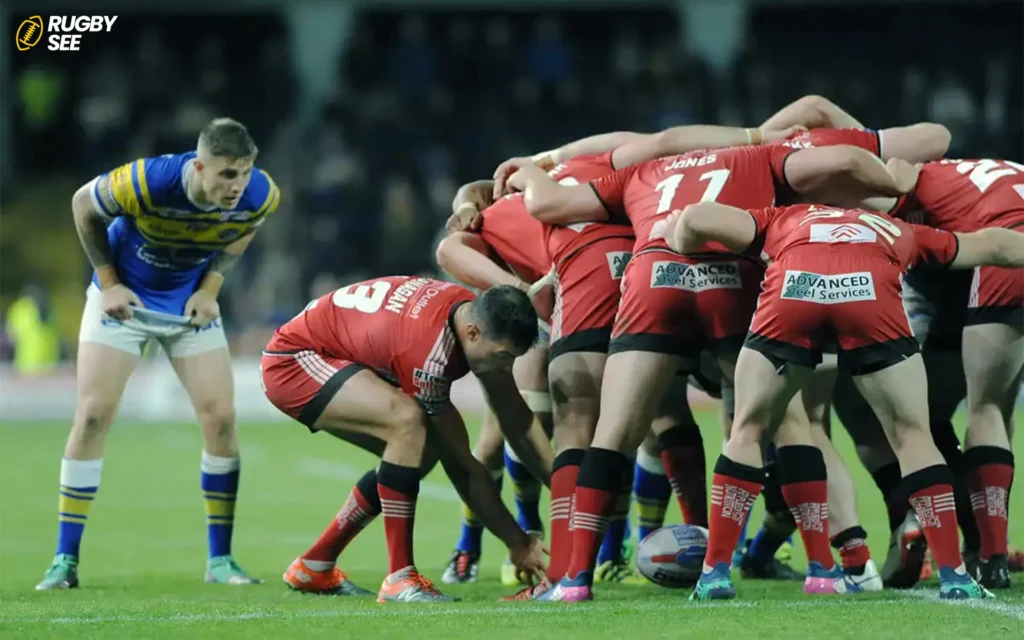Rugby league, a game renowned for its speed, strength, and strategy, features a distinctive element that often puzzles newcomers: the scrum. To the uninitiated, a scrum might seem like a chaotic tangle of players, but it holds significant strategic value in the game. This article delves into the purpose of a scrum in rugby league, unraveling its complexities and illustrating why it’s more than just a physical contest.
The Basics of a Scrum
A scrum in rugby league is a method of restarting play following minor infractions or stoppages, such as a forward pass or a knock-on. It involves six players from each team, known as the forwards, binding together in three rows and pushing against the opposing team’s scrum formation. The scrum half of the team awarded the scrum feeds the ball into the tunnel formed by the two sets of forwards, and the teams compete to gain possession of the ball.
Strategic Importance
The primary objective of a scrum is to secure possession of the ball. However, its strategic importance extends beyond just winning the ball. Scrums can be used to:
- Control the Game Pace: By securing the ball, a team can dictate the game’s tempo, either slowing it down to regroup or speeding it up to exploit the opposition’s disorganization.
- Positioning: Scrums often result in the ball being played back to the team that wins the scrum, allowing them to initiate set plays or attack strategies from advantageous positions.
- Psychological Advantage: Dominating a scrum can provide a psychological edge, showcasing physical dominance and teamwork that can intimidate opponents and boost team morale.

Evolution of the Scrum
Over the years, the role and execution of scrums in rugby league have evolved. Historically, scrums were more contested, with both teams vigorously vying for the ball. Modern rules, however, have seen the scrum become less about physical contest and more about restarting play quickly and safely, reflecting the game’s emphasis on speed and continuous action.
Safety Considerations
The structured nature of scrums in rugby league today is partly due to safety concerns. By ensuring proper engagement and reducing the contest for the ball, the risk of injuries associated with the scrum is minimized. This emphasis on safety helps maintain the dynamic and fast-paced nature of the game while protecting the players.
One of the advantages of choosing a scrum in the case of the upper hand is that if a team gives a scrum penalty more than twice, the player will be given a yellow card. Then the player is placed outside the field in the bin for ten minutes.
Previously, if an effort was made over the line, Scrum was done. However, the rule was changed and instead a goal-line knockdown was awarded as a point.
also if you want to know about rugby,s history and where this sport started from you can read What Country is Rugby From?
In the sport of rugby union, eight players from each team form a scrum. There is a three in the front, a second row of four and number 8 in the back. The ball is entered in the tunnel between both sets of players by the scrum-half of the team that received the free-kick.
Once the ball is in a team’s hands, they can keep it there and try to drive a team back, or they can roll the ball back to number 8, where it can be played to other players on the team.
The Role of Players in a Scrum
Each player in a scrum has a specific role, contributing to the team’s effort to win possession:
- Front Row: Comprising two props and the hooker, the front row’s job is to provide stability and support for the hooker to strike at the ball.
- Second Row: The two second-row forwards push against the front row, adding weight and power to the scrum.
- Lock Forward: Positioned at the back of the scrum, the lock forward adds extra force and controls the scrum’s direction and speed.
Understanding these roles is crucial for appreciating the tactical nuances of scrum play and the skill involved in executing a successful scrum and if you want to know more about scrum in rugby read Unpacking Rugby Scrum Penalties: A Comprehensive Guide.

Tactics and Techniques
Winning a scrum requires more than brute strength; it demands coordination, technique, and timing. Teams often practice scrum setups and engagements to perfect their approach, focusing on aspects like:
- Binding Technique: Proper binding ensures a stable and effective scrum.
- Timing of the Feed: The scrum half must time the feed to maximize their team’s chances of winning the ball.
- Communication: Team members must communicate effectively to coordinate their push and capitalize on the possession if they win the scrum.
The scrum is a fundamental aspect of rugby league that combines strategy, skill, and strength. Far from being a mere physical contest, it is a tactical element that can influence the outcome of the game. Understanding the purpose and intricacies of the scrum enriches one’s appreciation of rugby league, highlighting the depth of strategy that underpins this exhilarating sport. Whether you’re a seasoned fan or a curious newcomer, recognizing the significance of the scrum is key to grasping the full beauty of rugby league.










